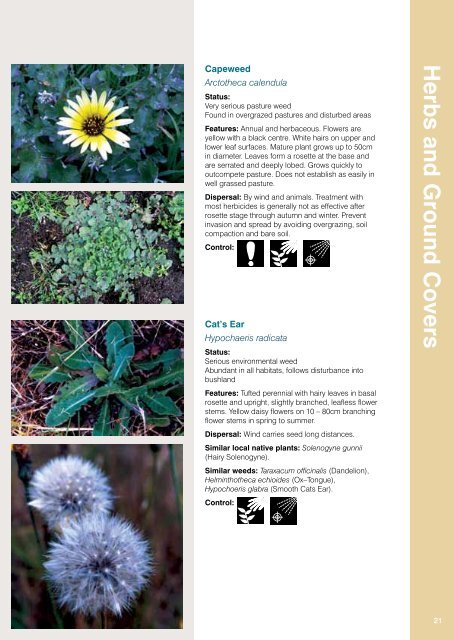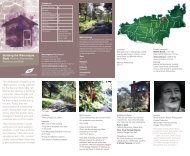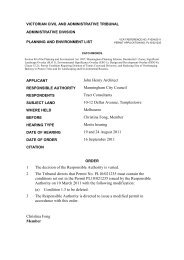Weeds Identification (PDF, 13MB, new window) - Manningham City ...
Weeds Identification (PDF, 13MB, new window) - Manningham City ...
Weeds Identification (PDF, 13MB, new window) - Manningham City ...
You also want an ePaper? Increase the reach of your titles
YUMPU automatically turns print PDFs into web optimized ePapers that Google loves.
Capeweed<br />
Arctotheca calendula<br />
Status:<br />
Very serious pasture weed<br />
Found in overgrazed pastures and disturbed areas<br />
Features: Annual and herbaceous. Flowers are<br />
yellow with a black centre. White hairs on upper and<br />
lower leaf surfaces. Mature plant grows up to 50cm<br />
in diameter. Leaves form a rosette at the base and<br />
are serrated and deeply lobed. Grows quickly to<br />
outcompete pasture. Does not establish as easily in<br />
well grassed pasture.<br />
Dispersal: By wind and animals. Treatment with<br />
most herbicides is generally not as effective after<br />
rosette stage through autumn and winter. Prevent<br />
invasion and spread by avoiding overgrazing, soil<br />
compaction and bare soil.<br />
Control:<br />
Cat’s Ear<br />
Hypochaeris radicata<br />
Status:<br />
Serious environmental weed<br />
Abundant in all habitats, follows disturbance into<br />
bushland<br />
Features: Tufted perennial with hairy leaves in basal<br />
rosette and upright, slightly branched, leafless flower<br />
stems. Yellow daisy flowers on 10 – 80cm branching<br />
flower stems in spring to summer.<br />
Dispersal: Wind carries seed long distances.<br />
Similar local native plants: Solenogyne gunnii<br />
(Hairy Solenogyne).<br />
Similar weeds: Taraxacum officinalis (Dandelion),<br />
Helminthotheca echioides (Ox–Tongue),<br />
Hypochoeris glabra (Smooth Cats Ear).<br />
Control:<br />
Herbs and Ground Covers<br />
21










